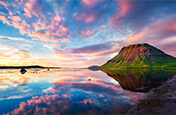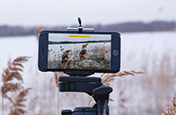A guide to principal photography.
It’s finally filming day and you’re ready to tackle your shot list like a pro. Learn the ins and outs of principal photography, plus get expert insight to help you to prepare for a successful day on set.

Lights, camera, action.
Principal photography is the creative execution phase of film production, sandwiched between pre-production and post-production. It’s when the actors are on set, the call sheets have been handed out, the lights are in place and the cameras are ready to roll. The only filming not considered principal photography is B-roll, which is usually filmed by a smaller second unit crew.
The first day of filming marks the point of no return for producers and investors. A project can lose its green-light status in pre-production if an actor drops out or financing falls through, but once filming begins there’s no way to recoup costs without seeing it through to completion. For a full-length film, the cinematography usually takes one to three months, but it could be as short as a couple of days, depending on the scale of the project.
The principles of principal photography.
Principal photography is where the action happens, but it’s also the most expensive phase of film production. Priority number one is making sure you run a tight ship with a rock-solid plan. “Production is so different from the other phases of the project because of time and stress,” says filmmaker Margaret Kurniawan. “You have to think about the time you’re spending on production as money. It’s not like in post where you can sit back and play with it for a long time. On set it’s a pressure cooker. So you need to be as prepared as possible.”


Reshoots eat up time and money, so the pre-production phase, which takes anywhere from three months to a year for a full-length motion picture, is critical for the success of the filming stage and the final product. Break down the costs of certain shots as best as you can, pre-visualise any CGI or special effects with concept artists and plan for any additional material you may need to film; it’s better to have extra material to bring into editing than not enough material.
“The idea is that it’s supposed to be a smooth process where all the kinks have been worked out in pre-production, so that once you start shooting, all you have to do is stick to the schedule, tackle your shots and move on,” adds filmmaker Hiroshi Hara.
A typical day on set.
The day before filming, the call sheet is sent out by the first assistant director or the producer.
Production is generally the first crew on set, as they’re responsible for preparing the set. The lighting crew also typically has an earlier call time. While these crews are at work, the talent will prepare with the makeup and costume teams. Once the set is ready, the crew will test the lighting with substitutes for the actual cast members, called stand-ins. This allows the team to make revisions to the set and lighting ahead of the lead actors’ arrival.
This is especially helpful if you’re working with non-actors or businesses. “You want to make the best use of their time. Set up and test your lighting, sound and camera with stand-ins so you can keep things running smoothly,” advises Kurniawan. This can also help you more confidently direct people who are not used to taking direction and being in front of the camera.

Since sets are potentially dangerous environments, with heavy lights, many cables and other hazardous set elements, every day should kick off with a safety meeting. It’s vital for everyone to be briefed on areas of caution for the day, especially the talent, who aren’t as familiar with the technical aspects of a set. After the safety meeting, it’s action time.
“The process gets repeated for however many shots the director needs. Sometimes it’s a big reset, like a location change. In these cases lighting, costume, lenses and more all need to be reset while the director consults with the director of photography on how to capture the next scene,” says Hara. After the day wraps, the cast and crew is dismissed to get ready to do it all over again the next day.
On the last day of filming, it’s customary to throw a “wrap party” to celebrate the completion of the production phase.
Who’s who on set?
A smaller project won’t have as many people present as a feature film production, but knowing the roles of each crew member is something every aspiring filmmaker should be aware of. Once you know how it works on a big set you can scale down your crew for smaller projects.
Producer
The producer buys the script and secures the funding for the film. You can think of the producer as the director of logistics. The producer is in charge of hiring a production company, who then hires whole crews of people on the production team. This includes a line producer, who hires and sets crew salaries and a unit production manager, who handles the day-to-day logistics on set.
Director
The director is in charge of all creative aspects of the film and works with the cast and crew to bring the creative vision to life. In smaller productions the director is almost always the producer as well.
First assistant director
Reporting to the director is the first assistant director (AD), who helps the director plan the shooting schedule and shot list. Often this person or the second AD, is responsible for sending out the call sheet the night before. A call sheet is a master schedule that outlines who needs to be where at what time. It’s common courtesy to send the call sheet out at least 24 hours before call time.
Director of photography
Also called the cinematographer, the director of photography (DP) is in charge of the camera team. In larger productions the DP doesn’t actually operate the camera but acts as a supervisor for the camera crew. The actual operation of the camera is left to the camera operator.
First assistant camera
The first assistant camera (AC) has one main job: pull the focus. This person is in charge of operating the focus ring on the camera to get each shot in focus and keep it in focus for the duration of the take.
Second assistant camera
The second AC operates the clapboard, which marks the start of each take. This person also takes notes during the filming to help the crew keep track of the positioning, gear and settings used.
Gaffer
As the head of the electrical department, the gaffer is in charge of lighting. They consult with producers and the director to visualise and execute a lighting plan for each scene.
Grip
The grip is a technician in charge of setting up and supporting the camera. Working with rigging, light modifiers and the dolly could all be part of their daily duties.
Sound mixer
In charge of recording sound on set, this person oversees all audio on set. They collaborate in tandem with sound designers, Foley artists and editors to determine how to approach each shot. Underneath the sound mixer is the boom operator, whose main responsibility is operating the overhead mic as the sound mixer monitors the recording.
Production designer
Production design is determined largely by this head of the art department, from location scouting to determining colour palettes and lighting. The set decorator, prop master, makeup artists, costume designers and production assistants all work with the production designer to bring the film’s creative vision to life.


Best practices for smoother filmmaking.
Filming days can be long and exhausting. It’s a massive team effort to make a single day run smoothly from first call to wrap party. Here are some pointers to help you to keep the cast and crew safe and comfortable on set.
Provide a craft services table. You don’t have to pull out all the stops with a caterer and lounge area, but you should have necessities like water and snacks on hand. Your cast and crew will thank you for thinking ahead for things like bathroom availability, parking or a shade tent. Additionally, it’s a mark of professionalism that talent and hired hands will remember should you want to work with them again. The Screen Actors Guild union outlines many regulations for the production process. Every 6 hours you must be provided with a meal break and you shouldn’t go over 12 hours of actual production. Even if you’re not working with SAG members, it’s best to adopt these practices early to prepare you for the industry.
While film sets are highly collaborative environments, there should be no overlap in responsibilities and roles. For example, the camera crew shouldn’t be moving any props around and if you’re not on the lighting team, don’t touch the lights. Sets are busy places with many moving parts, usually positioned to exact specification. If a light, prop or set piece is even a degree out of place, it could lead to a missed shot and subsequent reshoot. Stick to your job to avoid any miscommunications. “That’s how you keep continuity on set and it’s how you keep people safe,” says Kurniawan.
There’s a lot to juggle on filming days, but don’t lose sight of the fact that principal photography is the moment when you get to see your intensive planning work in pre-production come to life. Remember to have fun and enjoy as the process unfolds. Also, don’t forget about editing the video after filming.
Contributors
Do more with Adobe Premiere Pro.
Make visually stunning videos virtually anywhere — for film, TV and web.
You might also be interested in…
Understanding camera shots in film
Explore the most common camera shots and learn when and how to use them to greatest effect.
Learn how to create a shot list that guides the crew through all of the day’s camera set-up.
Learn how this helpful device can help you to capture great, stable footage.
Establishing shots are crucial because they tell us where and often when, the action is happening.
Get Adobe Premiere Pro
Create flawless productions with the industry-leading video editing software.
7 days free, then A$32.99/mo incl. GST.



